En esta publicación se discutirán datos de interés sobre una interesante familia de arañas conocida científicamente como Miturgidae, para ello se tomará como referencia y se describirá a uno de sus especímenes pertenecientes al género Teminius.
In this publication we will discuss data of interest about an interesting family of spiders known scientifically as Miturgidae, for this purpose we will take as reference and describe one of its specimens belonging to the genus Teminius.
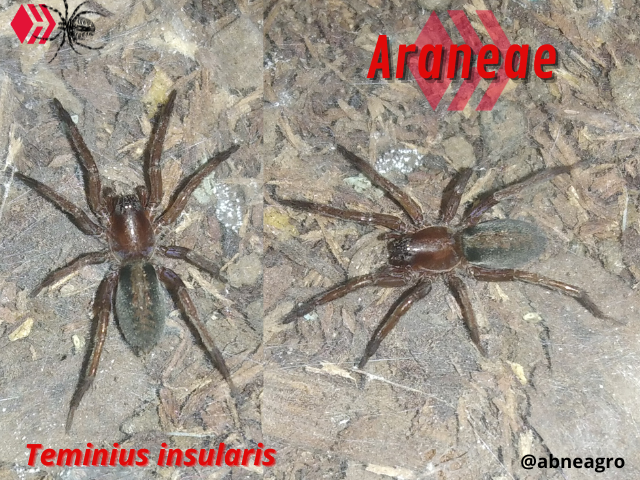
En la actualidad es muy común encontrar dentro de nuestros hogares a un sinfín de artrópodos, los cuales en su mayoría serán insectos por ser los más numerosos del planeta, pero también pueden llegar otros invertebrados atraídos por diversas razones. Los arácnidos como las arañas, generalmente entran en los espacios alterados por el hombre en búsqueda de alimento, para huir del mal tiempo o sencillamente se hospedan de manera indefinida, pues, muchas de sus especies se han adaptado para colonizar con éxito algún área de nuestras viviendas, aprovechando de manera efectiva la poca competencia y la gran fuente de alimento que encuentran generado por la fluctuación de artrópodos en espacios completamente desequilibrados desde el punto de vista natural.
En áreas antropogénicas por norma general, los insectos tienen muchas posibilidades de convertirse en plagas dañando a nuestras plantas o siendo vectores de importantes enfermedades, es por ello que las arañas más que representar un problema para nosotros terminan siendo aliadas, ya que estas son depredadoras generalistas de un gran número de invertebrados en los que se incluye como esenciales a los insectos.
Nowadays it is very common to find inside our homes an endless number of arthropods, most of them are insects because they are the most numerous on the planet, but other invertebrates can also arrive attracted for various reasons. Arachnids such as spiders, usually enter spaces altered by man in search of food, to flee from inclement weather or simply to stay indefinitely, as many of their species have adapted to successfully colonize some area of our homes, effectively taking advantage of the little competition and the great source of food they find generated by the fluctuation of arthropods in totally unbalanced spaces from the natural point of view.
In anthropogenic areas as a general rule, insects are very likely to become pests damaging our plants or being vectors of major diseases, which is why spiders rather than represent a problem for us end up being allies, as these are generalist predators of a large number of invertebrates in which insects are included as essential.
.png)
Por otro lado, estos arácnidos pueden llegar a ser un "problema" cuando las especies que invaden nuestras casas tienen cierto grado de importancia médica, pero afortunadamente, las arañas que pueden representar un peligro son una minoría muy marcada entre las más de 40.000 especies diferentes que existen en nuestro planeta, siendo los géneros Loxosceles, Latrodectus, Phoneutria y Sicarius los que tienen especies que pueden llegar en determinados casos a representar peligro por los efectos adversos que generan ciertos componentes de sus venenos. Sin embargo, el accionar de estas depende del nivel de estrés al que están sometidas, es decir, que mientras no se molesten no se defenderán, además de que en muchos casos pueden morder sin inocular veneno o por lo menos alguna cantidad considerable, ya que estas sustancias son muy valiosas para ellas, pues, son necesarias para someter a sus presas y poderse alimentar sin problemas.
Otros ejemplares como el que se presenta en esta publicación son de los más habituales, mismo que pertenece a la familia Miturgidae. Asimismo, otros miembros del orden Araneae de las familias Pholcidae, Araneidae, Salticidae, Lycosidae, Scytodidae o la Theridiidae por mencionar ejemplos, son de las más comunes que podemos encontrar dentro de casa, esto dependerá en cierta medida de la ubicación geográfica, ya que algunas pueden ser propias de algunos países (endémicas) y otras tienen una mayor distribución (cosmopolitas).
On the other hand, these arachnids can become a "problem" when the species that invade our homes have some degree of medical importance, but fortunately, the spiders that can represent a danger are a very marked minority among the more than 40,000 different species that exist on our planet, being the genera Loxosceles, Latrodectus, Phoneutria and Sicarius those that have species that can come in certain cases to represent danger by the adverse effects generated by certain components of their venoms. However, the action of these depends on the level of stress to which they are subjected, in short, as long as they are not disturbed they will not defend themselves, also in many cases the bite can go without inoculating venom or at least some considerable amount, since these substances are very valuable, since, they are necessary to subdue their prey and to be able to feed without problems.
Other specimens such as the one presented in this publication are among the most common, belonging to the family Miturgidae. Likewise, other members of the order Araneae of the families Pholcidae, Araneidae, Salticidae, Lycosidae, Scytodidae or the Theridiidae to cite examples, are among the most common that we can find in the interior, this will depend to some extent on the geographical location, since some may be specific to some countries (endemic) and others have a wider distribution (cosmopolitan).
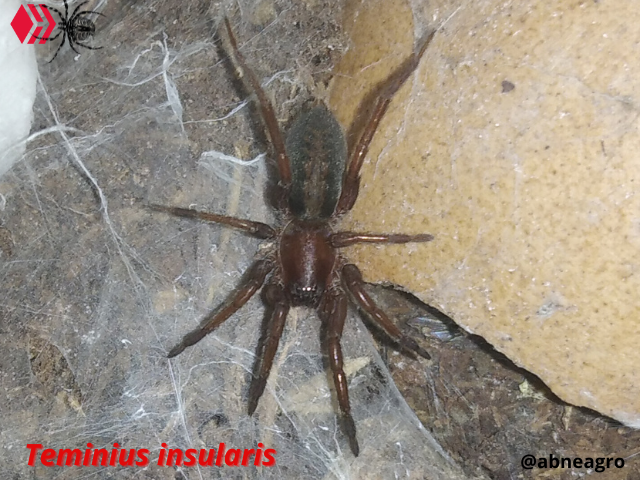.png)
La familia Miturgidae no destaca precisamente por ser muy numerosa, ya que dicho taxón solo se compone por poco más de 350 especies repartidas en 29 géneros, siendo el género más popular el Cheiracanthium, incluso este es el que conforma a una gran parte de dicha familia con más de 190 de las 350 especies identificadas hasta la fecha. No obstante, esto no les resta importancia ecológica al resto de especímenes que no pertenecen al ya mencionado género Cheiracanthium, ya que estas siguen cumpliendo con su rol natural de manera activa y pasando más desapercibidas hasta el punto de ser confundidas con otros tipos de arañas, en este punto se pueden mencionar a los integrantes de la subfamilia Miturginae, específicamente a los del género Teminius.
The family Miturgidae does not stand out precisely for being very numerous, since this taxon only consists of just over 350 species divided into 29 genera, the most popular being the genus Cheiracanthium, even this is the one that makes up much of the family with more than 190 of the 350 species identified to date. However, this does not detract from the ecological importance of the other specimens that do not belong to the aforementioned genus Cheiracanthium, which continue to perform their natural function actively and go unnoticed to the point of being confused with other types of spiders, such as members of the subfamily Miturginae, specifically those of the genus Teminius.
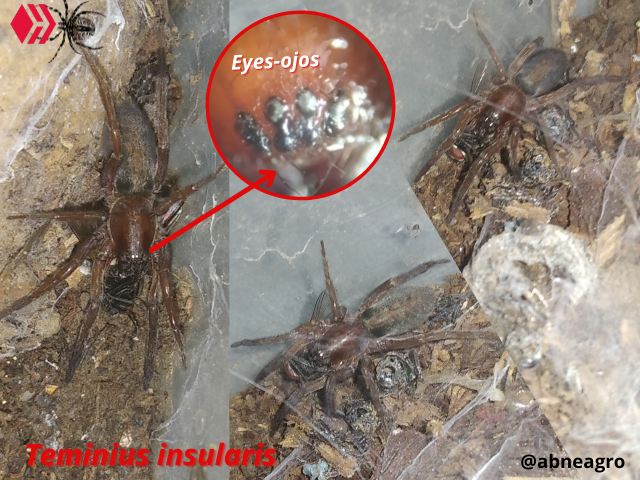.png)
Eventualmente, en horas nocturnas puedo observar a un gran número de arañas movilizándose a grandes velocidades por el suelo; si las zonas en donde las encuentro es muy frecuentada por el hombre, siempre las capturo para liberarlas en áreas más seguras, de esta manera evito que terminen muertas; sin embargo, hubo un ejemplar en particular que llamó mi atención debido a que inicialmente pensé al ojearla a simple vista que era de la familia Lycosidae (arañas lobo), pero luego empecé a ver detalles que me hicieron dudar, así que antes de liberarla me dispuse a estudiarla por unos días para determinar la especie. Tras una semana de observación los avances seguían siendo infructuosos, incluso las dudas aumentaron al encontrar ciertas similitudes con ejemplares de las familias Segestriidae, Zorocratidae y Agelenidae, de manera que, la tarea por identificar a la araña era cada vez más difícil.
A partir de este punto solo quedaba la opción más importante, la cual es observar más de cerca ciertas estructuras de su cuerpo evitando eliminarla o estresarla mucho, lo que fue la parte más difícil. Al apreciar lo ojos pude descartar automáticamente a la familia Segestriidae, ya que los miembros de dicha familia tienen solo 6 ojos, mientras que el espécimen que tenía en cautividad tiene 8 con una distribución muy similar a los de Agelenidae, por este mismo aspecto de la distribución y la forma ocular pude quitar de la lista a otras familias como Lycosidae y Zorocratidae, reduciendo la lista significativamente hasta el momento.
Eventually, at night hours I can observe a large number of spiders moving at high speeds on the ground; if the areas where I find them is very frequented by man, I always capture them to release them in safer areas, this way I avoid that they end up dead; However, there was one specimen in particular that caught my attention because I initially thought at first glance that it was of the family Lycosidae (wolf spiders), but then I began to see details that made me doubt, so before releasing it I decided to study it for a few days to determine the species. After a week of observation the advances were still unsuccessful, even the doubts increased when I found certain similarities with specimens of the families Segestriidae, Zorocratidae and Agelenidae, so that, the task to identify the spider was increasingly difficult.
From this point on there was only the most important option left, which is to observe more closely certain structures of its body avoiding eliminating it or stressing it too much, which was the most difficult part. By looking at the eyes I could automatically rule out the Segestriidae family, since the members of this family have only 6 eyes, while the specimen I had in captivity has 8 with a distribution very similar to those of Agelenidae, by this same aspect of distribution and eye shape I could remove from the list other families such as Lycosidae and Zorocratidae, reducing the list significantly so far.
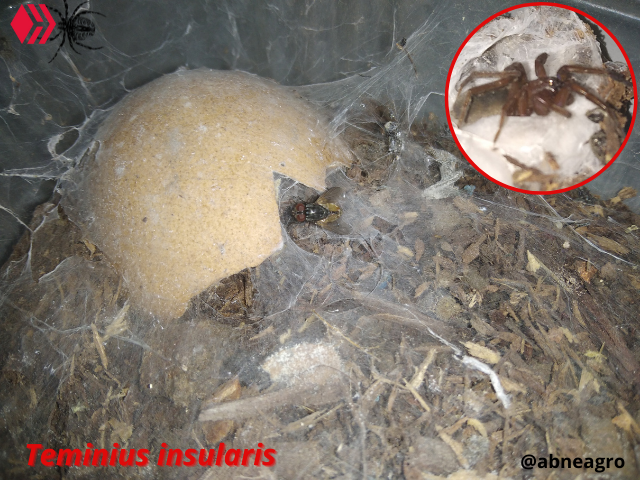.png)
Por otro lado, esta araña realizó una telaraña que cubrió todo el sustrato del recipiente en donde estaba de manera temporal, dicha capa de telaraña tenía algunas entradas y salidas, esta conducta reforzó más mi creencia de que era un integrante de la familia Agelenidae, teniendo ciertos aspectos morfológicos similares a las especies Agelena labyrinthica y al algunas del género Tegenaria. Aún así, Agelena labyrinthica no tiene ejemplares en America, por lo que pude descartarla, mientras que la Tegenaria domestica si está más extendida por el mundo hasta el punto de ser cosmopolita, en este punto todavía tenía dudas y realicé algunas consultas a otros compañeros, siendo estas negativas por el hecho de que realizar ciertas identificaciones por fotografías es muy complicado y las posibilidades que me dieron eran las mismas que ya había descartado.
On the other hand, this spider made a web that covered the entire substrate of the container where it was temporarily, this layer of web had some entrances and exits, this behavior further reinforced my belief that it was a member of the family Agelenidae, having certain morphological aspects similar to the species Agelena labyrinthica and some of the genus Tegenaria. Even so, Agelena labyrinthica has no specimens in America, so I could automatically discard it, while Tegenaria domestica is more widespread throughout the world to the point of being cosmopolitan, at this point I still had doubts and I made some consultations to other colleagues, being these negative by the fact that making certain identifications by photographs is very complicated and the possibilities they gave me were the same that I had already discarded.
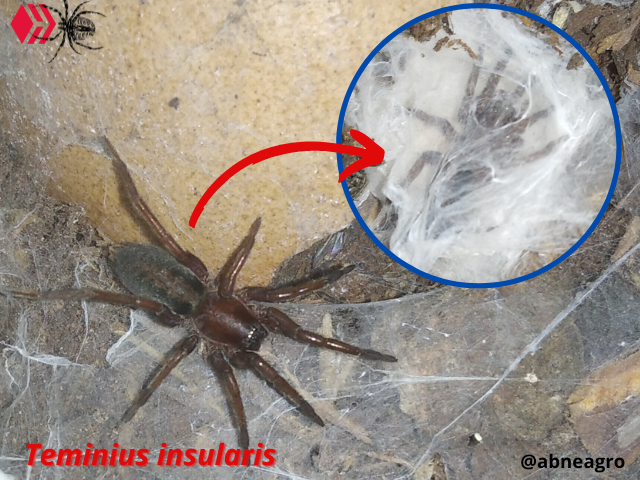.png)
Posteriormente, logré captar con más detalle las uñas tarsales de las patas, epigino y las hileras o espineretes al final de su opistosoma (abdomen); mediante estos nuevos detalles obtenidos y luego de realizar nuevas comparativas se genera un acercamiento morfológico y taxonómico hacia la familia Miturgidae, la cual no había pasado por mi cabeza. Gracias a esto se pudo identificar a la especie como miembro del género Teminius, siendo la especie una hembra de Teminius insularis, misma que se ubica en el continente americano y tiene distribución hacia el sur de dicho continente. La identificación de artrópodos en muchas ocasiones no es sencilla, debemos recordar que estos miembros del reino animal son los más numerosos del planeta y muchos de sus ejemplares poseen mucha similitud entre si, siendo necesario una observación detallada de ciertas estructuras de sus cuerpos para tener mayor certeza sobre la especie en su defecto; incluso ciertas aplicaciones que pueden funcionar como filtros fotográficos muchas veces no son de fiar y la información que arrojan puede estar errada.
Subsequently, I managed to capture in more detail the tarsal claws of the legs, epigynum and the rows or spinnerets at the end of its opisthosoma (abdomen); through these new details obtained and after making new comparisons, a morphological and taxonomic approach to the family Miturgidae is generated, which had not crossed my mind. Thanks to this it was possible to identify the species as a member of the genus Teminius, being the species a female of Teminius insularis, which is located in the American continent and has distribution towards the south of this continent. The identification of arthropods in many occasions is not simple, we must remember that these members of the animal kingdom are the most numerous of the planet and many of their specimens have much similarity between them, being necessary a detailed observation of certain structures of their bodies to have greater certainty about the species in its defect; even certain applications that can function as photographic filters many times are not reliable and the information that they throw can be wrong.
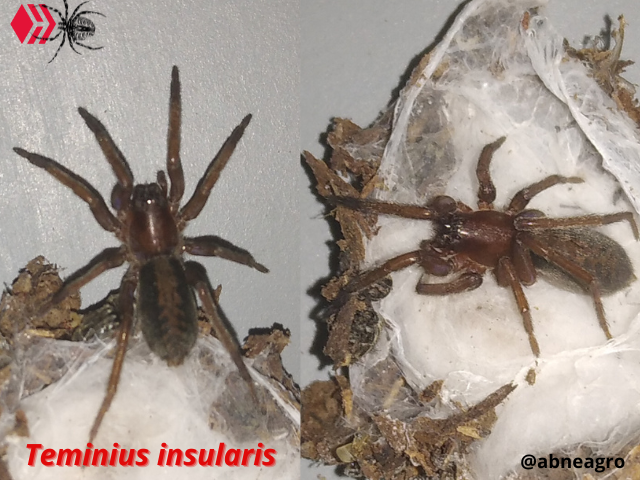.png)
Esta araña tiene una longitud de 12 milímetros y, al tratarse de una hembra, su opistosoma (abdomen) es alargado, el grosor que tiene en dicha área de su cuerpo es debido a que estaba grávida (embarazada); a su vez, su coloración predominante es el marrón claro tanto en el dorso de su prosoma como por la parte ventral, mientras que su opistosoma es grisáceo con un patrón mucho más claro en el dorso, se destaca que pueden existir ciertas variantes en el color, es decir, que ciertas zonas pueden ser más oscuras o un poco más claras. De igual manera, estas arañas se movilizan a gran velocidad por el suelo, por este motivo y por sus características externas pueden ser confundidas fácilmente con las populares arañas lobo de la familia Lycosidae, siendo necesario una observación detallada para evitar posibles confusiones.
This spider has a length of 12 millimeters and, being a female, its opisthosoma (abdomen) is elongated, the thickness it has in this area of its body is due to the fact that it was gravid (pregnant); In turn, its predominant coloration is light brown on the dorsum of its prosoma as well as on the ventral part, while its opisthosoma is grayish with a much lighter pattern on the dorsum, it should be noted that there may be certain variants in the color, that is, that certain areas may be darker or a little lighter. Likewise, these spiders move at high speed on the ground, for this reason and because of their external characteristics they can be easily confused with the popular wolf spiders of the family Lycosidae, being necessary a detailed observation to avoid possible confusions.

Generalmente, estas especies de arañas no son buenas tejedoras, por lo que optan más por merodear o movilizarse más por diversos lugares, son ejemplares que acechan a sus presas y, posteriormente, capturan a sus víctimas empleando el factor velocidad. Una vez que la presa es capturada, esta araña inoculará una pequeña dosis de veneno para paralizar y luego procede a alimentarse; pueden consumir prácticamente cualquier tipo de invertebrado que no supere en gran medida su tamaño, lo que las convierte en buenos controladores biológicos.
En la imagen esta hembra de Teminius insularis se dispone a elaborar un saco en donde resguardará sus huevos, este lo realizan colocando varias capas de telaraña, el centro o la zona en donde están los huevos es muy similar al algodón, sirviendo este como una especie de cama.
Generally, these species of spiders are not good weavers, so they opt more for prowling or moving around more in various places, they are specimens that stalk their prey and then capture their victims using the speed factor. Once the prey is captured, this spider will inoculate a small dose of venom to paralyze and then proceeds to feed; they can consume virtually any type of invertebrate that does not greatly exceed their size, which makes them good biological controllers.
In the image this female of Teminius insularis is preparing to elaborate a sack where she will shelter her eggs, this is done by placing several layers of spider web, the center or the area where the eggs are very similar to cotton, serving as a kind of bed.
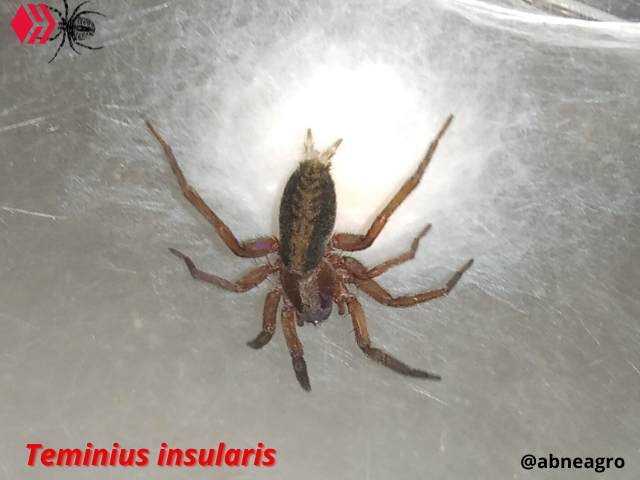.png)
La hembra suele quedarse un tiempo junto al saco de huevos; sin embargo, esta no permanecerá mucho tiempo en la zona, por lo que las crías deben sobrevivir por su cuenta, para ello pasarán los primeros días dentro del saco, posteriormente irán emergiendo y buscarán algún nuevo lugar para resguardarse o para buscar alimento, cada una tomará un camino distinto. Por otro lado, este tipo de arañas no representan peligro para el ser humano, hay algunas creencias que hablan de que el veneno de ciertos ejemplares de esta familia (Miturgidae) tienen compuestos en sus venenos que generan reacciones adversas en el organismo, pero no he visto algún estudio científico que compruebe que esto sea cierto, por lo que continuaran siendo especies muy comunes que frecuentemente pueden llegar a nuestros hogares.
The female usually stays for a while next to the egg sac; however, she will not stay long in the area, so the young must survive on their own, they will spend the first few days inside the sac, then they will emerge and look for a new place to shelter or to look for food, each one will take a different path. On the other hand, this type of spiders do not represent danger to humans, there are some beliefs that speak that the venom of certain specimens of this family (Miturgidae) have compounds in their venoms that generate adverse reactions in the body, but I have not seen any scientific study that proves this to be true, so they will continue to be very common species that can frequently come to our homes.
.gif)
Las arañas en general son más beneficiosas que perjudiciales, todas actúan como excelentes controladores biológicos, de manera que, antes de tenerles miedo y matarlas, siempre es recomendable que la captures con un recipiente y la liberes en algún lugar lejos de tu casa, así ganamos tanto nosotros como ellas.
Spiders in general are more beneficial than harmful, they all act as excellent biological controllers, so, before being afraid of them and killing them, it is always advisable to capture them with a container and release them somewhere away from the house, so we gain as much as they do.

Todas las imágenes compartidas en este post pertenecen al autor @abneagro. Las fotos fueron realizadas con un dispositivo móvil Redmi 8A y se editaron con la aplicación Canva.
All images shared in this post belong to the author @abneagro. The photos were taken with a Redmi 8A mobile device and edited with the Canva application. Translated via DeepL.

Some references:
Gabriel, César & Durán-Barrón, César. (2020). Arañas (Araneae).
Teminius insularis World spider catalog

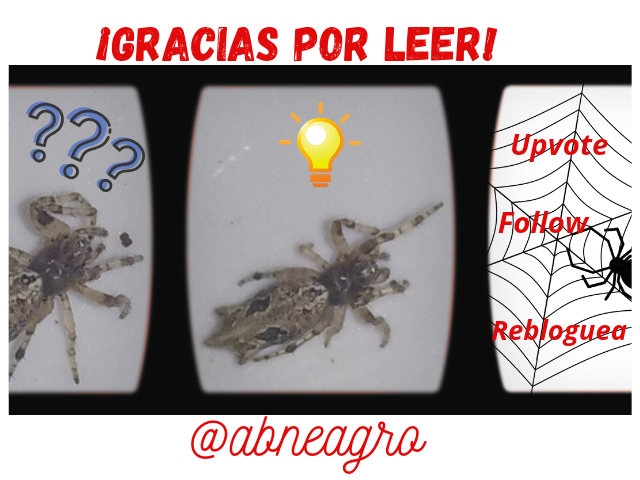
I very much appreciate the care you take to spare the spider from stress as you observe it. I also am impressed by the amount of effort you expend in order to correctly identify this spider.
The little bed the spider has made for its eggs is fascinating.
This fall my granddaughter is starting her college career at a school that has as its official symbol, the spider. The school has great respect for this arthropod, and so does my granddaughter. I hope that is a good sign for her future there :)
Thank you for this fascinating blog, and thank you for the translation.
Regards...
Yes, the identification of certain arthropods is not easy, so there are many species that despite being discovered, still do not have data that place them in a particular family or genus, others are initially placed in some group and after new discoveries move them to another. Sometimes it takes me more than a month to prepare an arthropod specimen for a post, especially if I include the whole phase of its development from egg to adult, this can be seen in some of the publications I have on butterflies and moths.
On the other hand, the bedding that the spider makes to protect its eggs is very similar to cotton, it uses several layers of webbing. Interesting about your granddaughter's school emblem, will she be studying something related to biology? Thanks so much for your support! Regards.
Hello @abneagro,
We love animals in my family, all kinds of animals. She hopes to major in health science and become an occupational therapist. Ultimately she would like to rehabilitate injured/sick animals. But she doesn't mind helping people, either:)
She is 17, though, and who knows what the future holds. (You can see I am a proud grandmother--forgive me 🙂)
You keep writing these wonderful articles: I'll keep reading them
Regards....
Ah she'll be a health professional, that'll be great. I thought he would study something related to biology because of his school emblem. I hope his future is bright and full of good things, although we always learn from all the negative things that happen to us on our path in this life. best regards!
Those pictures sound like having been taken in my garage :D I have so many spider and spider nests in there, especially after the summer when they all come in to protect themselves from winter temperatures.
That's right, atmospheric changes are one of the reasons why spiders and other arthropods invade our homes, some stay indefinitely while others only stay for a while. Hopefully those spiders living in your garage are of no medical significance, however, it is very likely that many of those nests are already abandoned. Thanks so much for the support and comment @lemouth, best regards!
I am cleaning their nests every year, around spring. This is a kind of heavy job, and I will have to do it again and again, year after year. The region I live in is indeed known for being good for those small "home spiders" (if you see what I mean with this term).
Cheers!
Cleaning is always fundamental to avoid the proliferation of these 8-legged hosts, often this task becomes difficult because they make their nests in places where it is more difficult to reach. If we do not clean the house becomes an ideal scenario for a horror movie haha :) Best regards!
I will pass for the horror movie at home :D
Cheers!
There are morphospecies of spiders of the genus Teminius that significantly affect the production of orange crops, the species Teminius insularis affects during the reproductive stage of the rice crop. Thank you, I liked the way you present your information.
Hi @agrovision welcome to my blog! I would like to know how spiders of the genus Teminius affect such crops. Weaver spiders such as those of the family Theridiidae or Araneidae hinder certain agricultural practices with their webs on the aerial parts of plants, which can sometimes damage the aesthetics or if the web is too much it can hinder the photosynthetic process. On the other hand, arachnids of the family Tetranychidae are considered potential pests, as these mites are phytophagous, but I have never heard or seen anything negative about spiders of the genus Teminius in crops, your comment is interesting for this reason. Thanks so much for stopping by and commenting, hope you are well!
The species of the genus Teminius, what they do is to obstruct the epidermal surface of the leaves, this indirectly affects the processes of photosynthesis and photorespiration, therefore, the effect that has been evaluated is the percentage that decreases the photosynthetic capacity, so far field trials have been reported in orange and rice crops.
These assessments are interesting. I would say that they are still specimens of low negative impact on agriculture, especially because they are solitary spiders, something contrary to what happens with some species of the Theridiidae family, which may have certain social behaviors by which they end up colonizing the plants of agroecosystems and wrap them in large webs. Thanks for commenting.
Hola @abneagro, que buen contenido!, Yo la hubiese confundido con una saltarina. Hace como dos meses vimos a uno de los perros enfrentando a una araña marrón grande. Ella levantaba sus patas tratando de defenderse. Pensando que podía ser venosa, se la quitamos y liberamos en el patio. Gracias por la información.
Holaa @elentogether. Si, las saltarinas son otras con las que se pueden confundir, pero las saltarinas tienen los 2 ojos intermedios muy grandes y son fácilmente visibles, esas son las más tiernas jajaja. Oye, hubiera sido interesante saber que araña se enfrentaba a una de tus mascotas, hicieron bien en evitar que alguno saliera lastimado. Un abrazo!
Gracias @abneagro, te enviare una foto de ella cuando encuentre. Es verdad que las saltarinas son lindas, parece que te miraran a los ojos.
Espero que encuentres alguna foto, así podría ver que tipo de araña es. Cuando las arañas levantan sus patas delanteras al acercar algo es porque están a la defensiva, ahí es cuando es mejor dejarlas tranquilas jeje.
Hola @abneagro, espero que estes bien. Encontré la foto de la araña, también envio una borrosa que me llamó la atención porque se ve una especie de brillo en la zona de los ojos.
Vaya, las fotos no son buenas para tratar de identificar, pero por lo menos te puedo asegurar que no es peligrosa. Si hubiera mordido a tu mascota el dolor que sentiría seria muy fuerte, eso si tenlo por seguro jajaja. Lo de los ojos es debido al impacto de la luz, se ven más terroríficas así jeje.
Muchas gracias por la información, es un alivio saber que no es venenosa. De todos modos hay algo que me asusta de ella: una vez entró otra más o menos por el mismo lugar y al rato entró una mapanare. Estaba siguiendola, ahora pienso que tal vez entren huyendo de ellas.
Si, eso me asusto mucho, cada vez que la araña lo hacía, el perro retrocedía
@malomi, estás malucamente desaparecida :(
Tu no le temes a las arañas, de igual sardinita las aleja jajaja.
Ohh !!! Jajajaja las arañas son fea jajajaja 😊😊 y no estoy segura que sardinita las aleje 😂😂😂😂
Te salvas que estás lejos por meterte con las pobres arañas jajajaja. Dios, creo que sardinita está muy toñeca jajajaja.
Su post ha sido valorado por @ramonycajal
Muchas gracias por el apoyo, saludos!
Thanks for your contribution to the STEMsocial community. Feel free to join us on discord to get to know the rest of us!
Please consider delegating to the @stemsocial account (85% of the curation rewards are returned).
You may also include @stemsocial as a beneficiary of the rewards of this post to get a stronger support.
We appreciate your work and your post has been manually curated by zoology team (oscurity,nelinoeva) on behalf of Amazing Nature Community. Keep up the good work!
a great post! great scientific contribution, excellent that you have the bibliographic citations!
Thank you very much for your support, I am glad that this publication has been to the liking of the members of this excellent community.
amazing post!
We appreciate your work and your post was manually curated by @none! from the DNA team!
Reach us on Discord to learn more about the project!